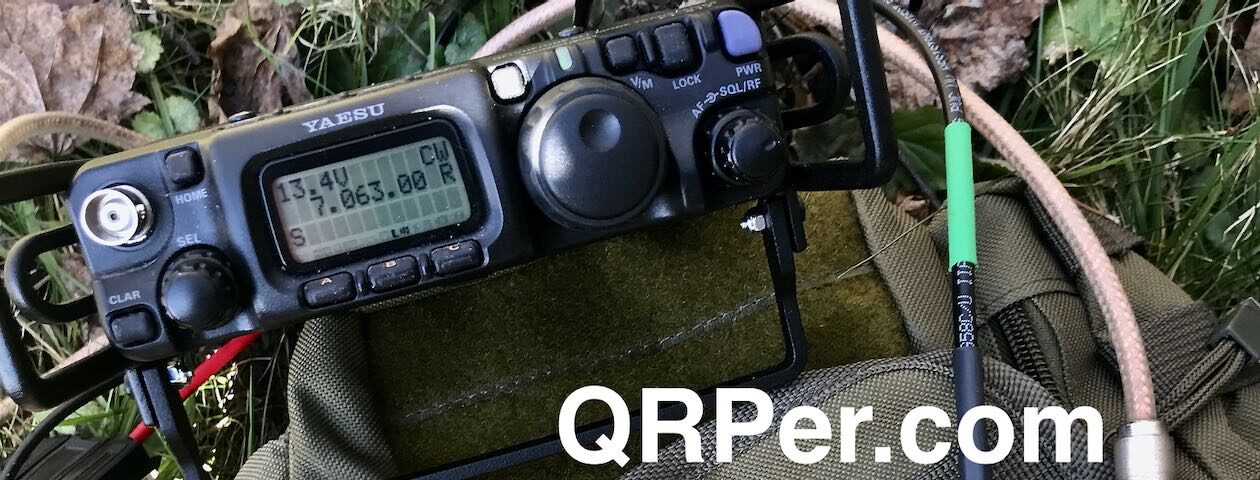Many thanks to Jay (W1ASP) who, last week, sent me a note about his first POTA CW activation. I asked if he’d consider writing up a short field report about his experience to share with others and he was happy to do so. Thank you, Jay.

Halloween POTA
by Jay (W1ASP)
Halloween doesn’t have to be scary.
I set out to Bear Brook State Park (K-2643) for my first CW POTA activation.
Bear Brook is relatively close by, its the largest state park in New Hampshire with over 10,000 acres. There’s camping, hiking and biking trails along with an archery course and plenty of swimming and fishing areas.

I didn’t give it much thought about what day it was, just that I had the time to do an activation and it was nice out, what a perfect opportunity to break in the newly assembled kit.

I decided on a spot next to the water and as luck would have it there was a picnic table right there. I took out my gear, set up and proceeded to tune around and listen. The band seemed pretty quiet. I wasn’t sure if I’d get enough QSO’s in to make it an official activation. I decided on 14.038 MHz, I sent QRL? I then held down the memory button, took a deep breath and hit it again to transmit: CQ POTA DE W1ASP
I waited a second or two and used the memory keyer once more, again nothing. I went to the POTA website on my phone and added my activation.
 The memory keyer was used for a third time, I noticed a message pop up on my logging app, the Reverse Beacon Network spotted me. It wasn’t too long after, the first call came back to me!
The memory keyer was used for a third time, I noticed a message pop up on my logging app, the Reverse Beacon Network spotted me. It wasn’t too long after, the first call came back to me!

I was nervous and fumbled a bit here and there but once I took my time I was fine, sending their call back and TU UR 599 599 NH BK. I cheated a little and left the CW decoder enabled. I wanted to be sure I had the call correct as I logged my 13 QSO’s. (I swear the 13 wasn’t intentional.) for my first CW park activation! I only realized that it was Halloween while walking back to my truck.
I thought to myself, “that wasn’t scary at all.”
Once I decided that, as an activator I’m in charge of the QSO, I relaxed and it was a lot of fun. I may have made a few mistakes but everyone was patient with me. I later received an email from another Ham in Delaware. He was using the same radio, and referred to them as the perfect “picnic portable radio” we emailed back and forth a few times and I look forward to hearing him on the air again soon.
The week before, I finished building my second QCX Mini. The first kit I built was for the 30 meter band around this time last year, this second one is a 20 meter version. I love these little radios, there’s something about these little transceivers that I just can’t seem to put them down.
I took my time making sure it was working properly, I hooked it up in my shack and I had my first QSO with another POTO activator in Maryland just over 400 miles away. To say I was excited is an understatement!
I planned on putting together a kit about a month ago for POTA and eventually SOTA with the QCX Mini as the radio. I decided on using a small pack, I wanted it to be a self contained kit that had everything I needed to do an activation and nothing extra.

I keep the wire and radios together, and depending what band I choose to operate on is the one I pack. I’m considering a third kit; maybe a 10m version? I threw the EFHW matching transformer in the bag along with a notebook, mechanical pencil and a battery pack I put together using four 3.2v LifePo batteries. The paddle I’m currently using is a stainless paddle I found on online with a mini CW paddle for backup and set of folding headphones.

I’m looking forward to my next park, this was a great experience. I wanted to learn CW since I became a Ham in 2016, that’s another story of what got me into Ham Radio in the first place.
 I mentioned in a previous post that I’m quite behind publishing activation videos. Much of this has to do with the fact that I’ve been a pretty busy activator (by my standards) the past couple of months.
I mentioned in a previous post that I’m quite behind publishing activation videos. Much of this has to do with the fact that I’ve been a pretty busy activator (by my standards) the past couple of months. In the previous field report (from October 14, 2022), I recounted two amazing SOTA activations in north Georgia (Big Cedar and Black Mountain) with my buddy Joshua (KO4AWH) during the annual W4 SOTA Fall Campout.
In the previous field report (from October 14, 2022), I recounted two amazing SOTA activations in north Georgia (Big Cedar and Black Mountain) with my buddy Joshua (KO4AWH) during the annual W4 SOTA Fall Campout.

































